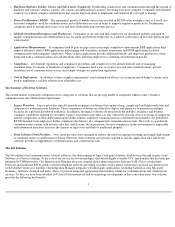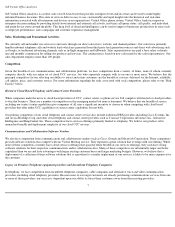8x8 2015 Annual Report Download - page 17
Download and view the complete annual report
Please find page 17 of the 2015 8x8 annual report below. You can navigate through the pages in the report by either clicking on the pages listed below, or by using the keyword search tool below to find specific information within the annual report.
In connection with our cloud telephony services, we face competition from incumbent telephone companies, cable companies and alternative
voice and video communication providers, including other providers of cloud telephony services. Because most of our target customers are
already purchasing communications services from one or more of these providers, our success is dependent upon our ability to attract these
customers away from their existing providers. The incumbent telephone companies are our primary competitors in cloud communications and
collaboration. These competitors include AT&T, CenturyLink and Verizon
Communications as well as rural incumbents, such as Windstream. In
addition, in connection with all of our collaboration and communications services, we face competition from traditional private branch exchange,
or PBX, providers, including Cisco Systems and Avaya and other providers of cloud telephony and contact center services, such as Comcast,
inContact, Microsoft and RingCentral.
Many of our current and potential competitors have longer operating histories, significantly greater resources and brand awareness, and a larger
base of customers than we have. As a result, these competitors may have greater credibility with our existing and potential customers. They also
may be able to adopt more aggressive pricing policies and devote greater resources to the development, promotion and sale of their products than
we can to ours. Our competitors may also offer bundled service arrangements that offer a more complete or better integrated product to
customers. Competition could decrease our prices, reduce our sales, lower our gross profits or decrease our market share. In addition, our
customers are not subject to long-term contractual commitments to purchase our services and can terminate our service and switch to
competitors' offerings on short notice.
Given the significant price competition in the markets for our services, we are at a significant disadvantage compared with many of our
competitors, especially those with substantially greater resources who may be better able to withstand an extended period of downward pricing
pressure. The adverse impact of a shortfall in our revenues may be magnified by our inability to adjust our expenses to compensate for such
shortfall. Announcements, or expectations, as to the introduction of new products and technologies by our competitors or us could cause
customers to defer purchases of our existing products, which also could have a material adverse effect on our business, financial condition or
operating results.
Because we recognize revenue from customer subscriptions over the term of the relevant contract, the effects of customer additions,
cancellations and changes in subscribed services are not immediately reflected in full in our operating results.
As a subscription-based business, we recognize revenue over the term of each of our contracts, which generally range from one to five years. As
a result, much of the revenue we report each quarter results from contracts entered into during previous quarters. Consequently, a shortfall in
demand for our cloud communications and collaboration services or a decline in new or renewed contracts in any one quarter may not
significantly reduce our revenue for that quarter but could negatively affect our revenue in future quarters. Accordingly, the effect of significant
downturns in new sales or cancellations of our services and subscriptions from new customers or for additional services from existing customers
will impact our ongoing monthly recurring revenue but will not be reflected fully in our operating results until future periods. Our revenue
recognition model also makes it difficult for us to rapidly increase our revenue through additional sales in any period, as revenue from new
customers must be recognized over the applicable term of the contracts.
We have a history of losses and are uncertain of our future profitability.
We recorded operating income of $3.9 million for the fiscal year ended March 31, 2015 and ended the period with an accumulated deficit of
$104.7 million. Although we have achieved operating income in each of our five most recent fiscal years, we suffered substantial operating
losses prior to that and may incur operating losses in the future, which may be substantial. As we expand our geographic reach and service
offerings, and further invest in research and development and sales and marketing, we will need to increase revenues in order to generate
sustainable operating profit. Given our history of fluctuating revenues and operating losses, we cannot be certain that we will be able to maintain
operating profitability on an annual basis or on a quarterly basis in the future.
A higher rate of customer cancellations would negatively affect our business by reducing our revenue or requiring us to spend more
money to grow our customer base.
Our customers generally do not have long-term contracts with us and may discontinue their subscriptions for our services after the expiration of
their subscription period, which range from one to five years. In addition, our customers may renew for lower subscription amounts or for
shorter contract lengths. We may not accurately predict cancellation rates for our customers. Our cancellation rates may increase or fluctuate as a
result of a number of factors, including customer usage, pricing changes, number of applications used by our customers, customer satisfaction
with our service, the acquisition of our customers by other companies and deteriorating general economic conditions. If our customers do not
renew their subscriptions for our service or decrease the amount they spend with us, our revenue will decline and our business will suffer.
13
























